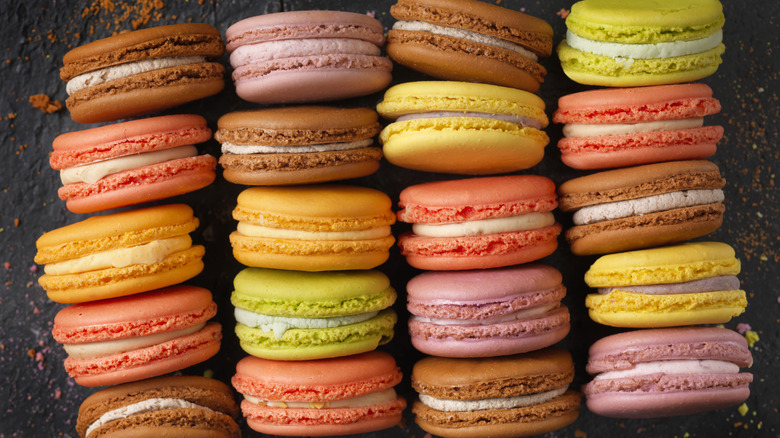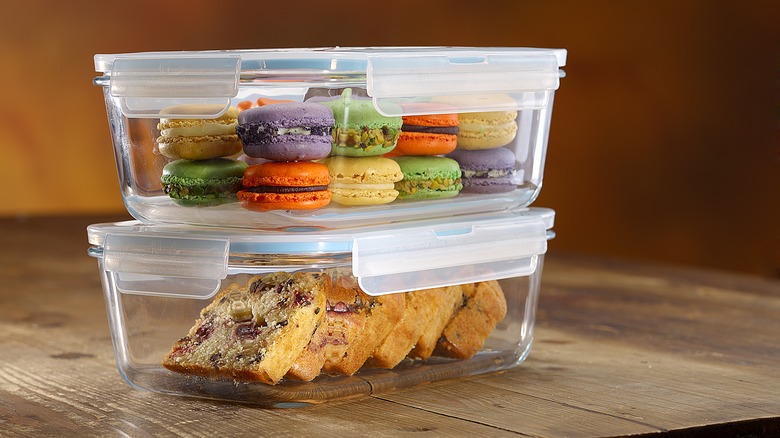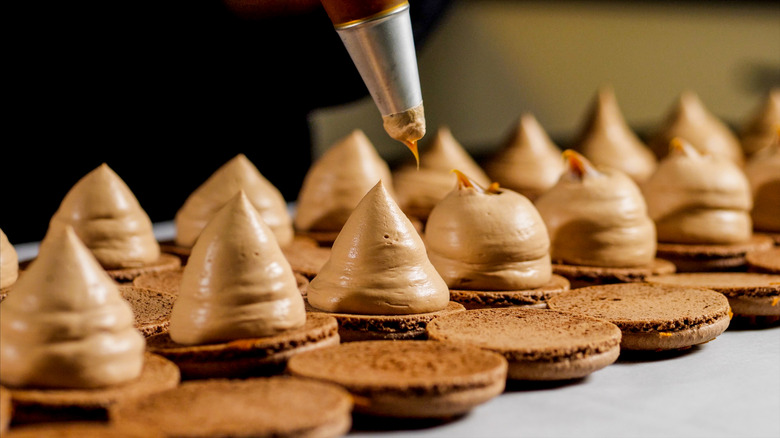Will Macarons Last Longer At Room Temp Or In The Fridge?
Procuring delicate, colorful macarons requires an investment of either time or money. These labor-intensive cookies make for a delightful bakery purchase and can also be a welcome baking challenge. Once the treats are in reach, it can be tempting to stash them in the corner of your kitchen to enjoy later.
Yet, the question is whether they hold up better in the fridge or on the counter. The gluten-free French pastry — not to be confused with coconut macaroons — is essentially a sandwich of meringue shells made from almond flour and egg whites that's stuffed with a filling of jam, cream, or ganache. Each shell is airy and fragile, making it all the more important that macarons are stored properly.
And the truth is you're better off storing them in a sealed container in the fridge for longer periods until you're ready to eat them. If that dinner party gets postponed, for example, stash the pastel pastries in the freezer to further extend their shelf-life by up to a month. The trick to making sure they're still aromatic and filled with contrasting textures once you go to eat them is to allow the treats to come to room temperature before serving.
The benefits of storing macarons in the fridge
Macarons from a patisserie are best the day you buy them. But if you buy a dozen or more, and plan to polish off the bakery purchase within another day or so, you can store them in an airtight container at room temperature. They'll survive sitting out for that short period of time.
However, bakeries often recommend placing these cookies in a colder environment if you need a longer time to enjoy them — anywhere from four days to a week — to keep them fresh. The wet fillings will continue to absorb into the meringue shells, so keep in mind they may have less of a crisp snap if you leave them to languish.
Homemade macarons, on the other hand, may actually benefit from time to chill. Although you can serve classic macarons right after you've finished assembling them, pastry chefs extol the virtues of aging or maturing finished pastries in the fridge for a day — or a few days — to allow the textures to meld. The crispy meringue's interior will moisten and take on more of a chewiness, rather than shattering on impact.
Making creative and flavorful macarons
As anyone who watches baking competition shows may know, making macarons from scratch is a challenge. The task requires making an airy dough, piping it into perfect circles, banging out any air bubbles, and allowing each round to form a skin — all before even putting them in the oven! Accomplishing the feat, however, will give you an abundance of bragging rights, invaluable pastry skills, and — best of all — the chance to customize the adaptable dessert to your taste.
The lightly-flavored shells pair with any number of caramels and jellies, making them a charming canvas for culinary exploration. For those tempted by the task, try adding rose water to make a creamy dessert filling or infusing tea for an aromatic component. Or mix and match the top and bottom shells, as well as the fillings, to experiment with pairings like matcha and black sesame, ube and coconut, or citrus and saffron.
Cooks ready to walk on the wild side can also attempt a less common bakery offering: savory macarons. Take inspiration from French hors d'oeuvres and make bright beet shells filled with sharp goat cheese and fig or bacon jam. You can also stuff shells with tangy cream cheese, smoked salmon, and a hint of caviar for added texture. Although it is possible to mix up saltier bites, like soup-inspired tomato and chicken-stuffed cookies, it's tricky to balance the sweetness, so budget in time for trial and error.



